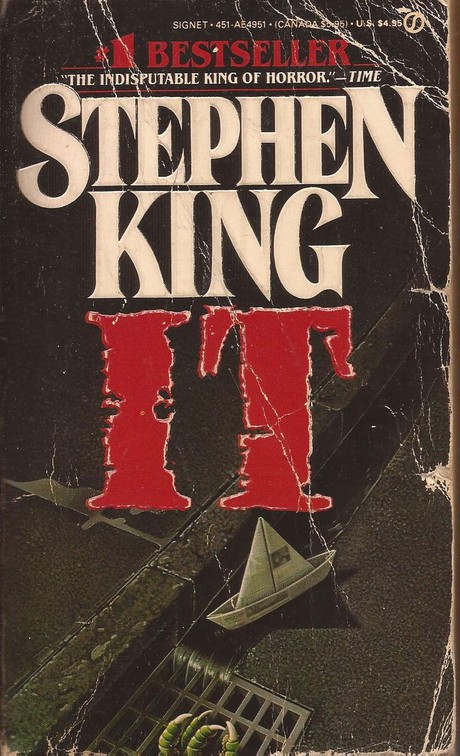
Ahoy, squirts! Quint here. I was in sixth grade when I read my first Stephen King book. My mom always had King books around the house and being a little horror kid I was always curious, but reading a grown up book was just something I never even thought was possible. Sure, I could read The Hobbit or whatever age-appropriate book they'd have us read at school, but for whatever reason I had it in my mind that I just wouldn't understand a non-kids book. I might as well pick up a book written in Mandarin Chinese.
Being a horror kid I saw a lot of scary movies, so I knew King's name from the movie adaptations of Carrie, Cujo, The Shining and Stand By Me. Child's logic is a funny thing. I was looking at my mom's battered paperback of Cujo, staring at the illustration of a St. Bernard's sharp teeth, dripping with rabies slobber, and thought “I might be able to translate this because I've seen the movie.”
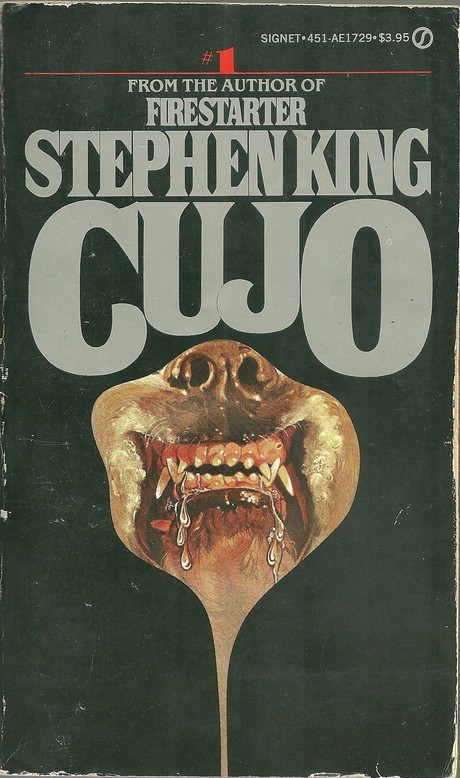
It was a simple story, a woman and her son trapped in a car by a killer dog. How tough could that be? So, I read it. I don't recall how long it took me to get through that relatively short book, but it wasn't long. I brought it with me to school, kept it secured in my pencil box as to not get in trouble for reading something too crazy while my teacher was around, and filled up all my spare time reading. And I had a lot of spare time. This was prior to the Internet, remember, so it wasn't as easy to occupy yourself with the world's combined knowledge always at your fingertips.
King's ability to get inside the minds of his characters was unlike anything I had ever read before. The terror of the monster that lurked in Tad Trenton's closet felt real because I was seeing it through that character's eyes, reading his thoughts. He even put me in the mind of the loveable dog who, through no fault of his own, goes mad. Then the whopper of an ending, much darker than the movie, took me by surprise.
I was hooked.
It was then and there that I decided I was going to read everything Stephen King ever wrote. I was looking down the barrel of 6 more boring years of middle and high school, after all. Something was going to have to help me through all that.
The King books that I had already seen adaptations of were my training wheels. That's how I got to It so quickly. I had, of course, seen the mini-series. That was actually an event in my household. We gathered around when it premiered and watched it as a family. That just how awesome my upbringing was.
The book was a whole different beast. So much more rich, so much more pants-shittingly terrifying, so much more involving.
I recently finished a re-read of this huge tome. I started last year before I visited the set of the movie. I had been feeling the pull to revisit my friends in Derry already, but when I found out I was going to visit the set I wanted it to be fresh in my mind.
Right off the bat I was struck by something kind of incredible. It occurred to me that I was about the age of the kids in the Losers Club when I first read the book and I'm now about the age of their adult counterparts. I couldn't have been older than 13 when I read It for the first time and I'm now on the cusp of middle age.
The book is not like the mini-series or the upcoming film. King doesn't split the narrative between kids and adults. He intertwines them. As it reads the adventure of their youth informs their last ditch attempt to finally kill this evil. The “modern” '80s characters are slowly remembering their past and as they do we, as readers, get to experience those memories first hand.
Naturally, as a child myself reading this book for the first time I was way more interested in the '50s story because I related a lot more to the kids. They became my friends. I felt like I was on their journey with them. I understood each person, Bill, Bev, Eddie, Richie, Mike, Stan and Ben, in a way only a child reading about children can.
Narratively there's a reason for that. The adults are purely reactionary until the very end, when the surviving members finally descend into It's lair one more time. The kids, throughout all 1200 pages, are proactive. They survive Pennywise and the other masks It wears, band together and make a plan to stop it. Unlike the mini-series they attempt this plan more than once, first in the creepy house on Neibolt Street, where they injure the monster and once again in the sewers.
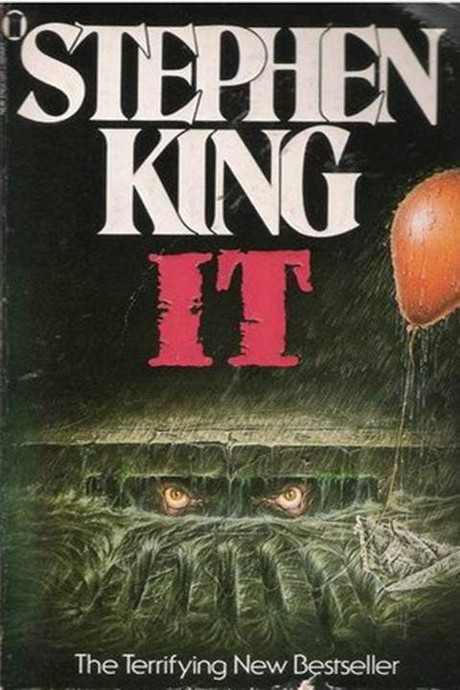
Upon this re-read I found I was noticing things that flew over my head the first time around, mostly in how King crafted the story. He does something particularly interesting in the first 200 pages that blew my mind a little bit.
One of the author's greatest talents is creating characters you recognize and believe could actually be real and the way he does that is put you behind their eyes. He doesn't write from a God perspective, he describes whatever the chapter is about through the eyes of the character he is focusing on. In short, we get to be them for whole chunks of the book.
The creative choice that blew my mind upon this reread was that for nearly the first 200 pages he doesn't do that. Instead, he gives the point of view to minor characters around our main characters.
The opening of the story is It returning and Mike Hanlon, the only member of the Losers Club who stayed in Derry, realizing it's time to call his friends to come back and finish It off once and for all. Outside of Mike Hanlon we're introduced to all the main characters through the perspective of someone else and even most of Mike's inner thoughts are told to us via his journal.
For instance, when Bill Denbrough gets the call we see the whole scene from the point of view of his wife, Audra. When Ben Hanscom gets the news he walks into a bar and has a conversation with a bartender about it and we're only ever in the point of view of the bartender. When Beverly Marsh gets the call we're behind the eyes of her jealous, abusive husband, feeling him get more and more annoyed and suspicious as his wife takes a late night call from a strange man. Both Eddie and Stan's wives are our eyes and ears when they are reminded of the promise they made to come back if It isn't dead.
It's a fascinating choice because it does two things: It allows King to have the same conversation seven times without having to repeat himself and it fleshes out the world in a way that only grounds the story more. Stan's wife gets a dozen pages of backstory. We know where she is as a person, who her husband is as an adult (important because we don't actually get to spend much time with adult Stan) and the feeling of mystery surrounding this fateful phone call. She doesn't know about the kid-killing monster that lives in the sewers of Derry, Maine.
The best example of this working as a narrative tool is with Tom Rogan, Beverly's asshole husband. This could have easily been a one-note character. He's kind of the typical wife-beating male chauvinist '80s exec douchbag on the surface and would have remained so if we didn't get a chapter to live in his mind.
He's still a monster, don't get me wrong, but you feel his insecurities and paranoia and suddenly there's a little more depth there. You understand why he'd follow Beverly to Derry and why his shortcomings make him such an easy target for It when he gets into town.
King doesn't really jump into the minds of our leads until the first full on '50s flashback with Ben Hanscom, in which Ben finds himself pining over Beverly on the last day of school.
Ben was a major character for me as a kid. A chubby, quiet, lovelorn bookworm who spent his free time at the library? As the kids say these days, that me. I related to all the members of the Losers Club in some way, but I saw myself in Ben. I was never as smart as the Ben in the book, but that only granted me a little extra wish fulfillment.
Like Ben I had a little group I'd run around with and much like the kids of the '50s I pretty much spent my summers outside roaming with them, doing stuff that just wouldn't fly in today's society. I don't think too many kids these days are allowed to wander sprawling apartment complexes, greenbelts and neighboring suburbs by themselves. It was a simpler time in the '80s.
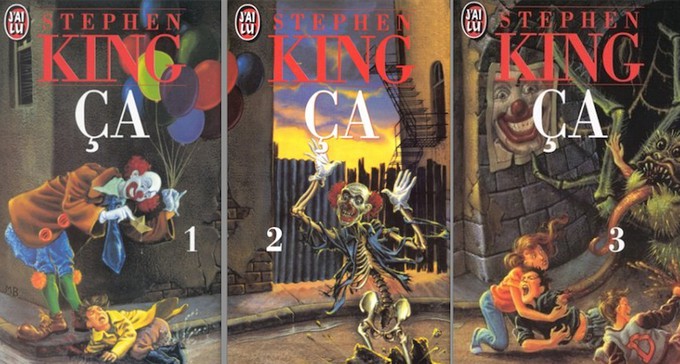
Being the fat kid I was also an easy target for the more cruel kids at school. Thank God there was no one near as vile as Henry Bowers, but that was another angle I could relate with.
Unlike Ben, my main crush wasn't on a sweet, kind girl like Beverly. No, the one that caught my eye was a very cute, but pretty fuckin' mean girl named Hanna. Maybe she sensed my interest and that's why she went out of her way to be cruel to me or maybe she was just a dogshit person. I haven't kept tabs on anybody, even my closer friends, from that era of my life so I can't tell you what kind of person she grew in to, but as a kid she was pretty awful. No exaggeration, I broke my hand in a bicycle accident on school grounds (after hours) and she and her friends literally pointed and laughed as I was curled up on the ground, crying in the worst pain I've ever felt in my life. However, I still crushed on her anyway because she was pretty and that's about the all that matters when you're 11 and starting to get feelings about the opposite sex.
I also had a few cool Tomboy friends that I palled around with that could closer fit the Beverly Marsh mold. My point is even with my limited life experience this story and these characters spoke to me. I recognized pieces of each character in the story, good, bad or neutral, in my own personality and the ones I saw around me at school.
That right there is why, as a kid, I was so enraptured with this book. To paraphrase the bookstore owner in The Neverending Story, this book was real to me. The novel is so long that you get to a point where it feels like you're turning pages and not getting any nearer to the end and I vividly remember getting about halfway through and hoping that I would keep flipping pages forever. I wanted this book to be an eternal portal into the lives and stories of these people.
The only sections of the book that I lost any patience with were the tangents into Derry's history. I was never outright bored with them, but they weren't filled with monsters or the characters I had come to think of as friends.
Imagine my surprise when I found those to be some of my favorite parts of this latest re-read.
The book takes detours into Derry's backstory from time to time, telling stories of past tragedies like a fire started by an angry white mob at an all-Black nightclub called The Black Spot, a slew of ax murders conducted by an insane lumberjack that's observed by those around it as if he was clapping his victims on the back instead of burying his ax into their heads, and a Bonnie & Clyde style slaughter of some gangsters known as the Bradley Gang. As a kid I just took this to show that It has been a part of Derry for a long time, but as an adult I pulled something a little deeper from these sections.
It hasn't been a part of the town. It IS the town. Derry is It and It is Derry. The entity behind the clown isn't literally the paved streets and stone buildings, but there's a symbiotic relationship between the community as a whole and the evil the lurks underneath it.
This is foreshadowed by all the backstory elements, most notably in the Bradley Gang section where the normal, average everyday townspeople took to the street to murder this gang of outsiders. It's beyond mere mob justice, it's like everybody's under a spell. Afterward the people who took part remember seeing Pennywise there, but everybody sees something different. If a man fired a Winchester rifle at the gang members he remembers Pennywise firing a Winchester rifle. If another fired a pistol, he remembers Pennywise firing a pistol. It is them.
At the end of the book this is underlined. When It is finally destroyed for good by the surviving members of the Losers Club the city of Derry literally breaks apart. Streets collapse, buildings fall, homes crumble. When It is destroyed so is Derry.
That stuff is hinted at in the mini-series, but never made explicit. I'm hoping that's something the eventual theatrical sequel dives in to. When I talked with Andy Muschietti and his producers on the set of It they said they were very keen on rolling The Black Spot story into the sequel should that get the greenlight and I think that's a very smart way for them liven up the adult section of the book.
Speaking of backstory that's not really featured in any of the adaptations, one of the biggest surprises on this re-read was getting to the chapters dealing with It's origins. I had totally forgotten about the Smoke Hole sequence.
The Losers Club builds an underground club house with a trap door ceiling covered in sod so it is completely hidden from the surface. Ben reads about an old Indian tradition of the Smoke Hole, which is supposed to give warriors and elders visions of what to do when a big decision needed to be made and the Losers all agree that this is what needs to happen for them to decide on how to kill It.
This is a great sequence for multiple reasons. For one, Bev gets to establish she's firmly 100% on equal footing with the boys. They try to exclude her because she's a girl (and they also realize it's really stupid to smoke up a room with nobody outside to help should they all pass out), but she flips out, going so far as to call Bill, who she has deep feelings and admiration for, by his not-flattering nickname 'Stuttering Bill.' She threatens to break up the group, which would surely end any chance of stopping Pennywise, if they don't treat her equally.
They reluctantly agree, still thinking it's smarter for one of the group to stay outside to pull them out should they get overwhelmed by the smoke. They decide the only fair way around this is to draw straws, which they do in the form of match heads. One is burnt and whoever pulls the burnt one has to sit outside and act as insurance in case the other members pass out.
As they draw the matches, each and every member of the club tells Bev they love her, the first time this is vocalized. It's not done romantically, with the possible exception of Ben, but earnestly and matter of factly. This is where their bond as a group begins to cement (and not in as weird a way as the sex scene that seals this bond later in the book, but we'll get that in a bit).
Each member of the club pulls an unburnt matchstick, leaving Beverly with the burnt one... or so they think. Something outside of the group is guiding them, a supernatural force that is Its equal and opposite counterpart, and when Beverly looks at the remaining match it is unburnt. This force that drew them together and is putting them in the path of Pennywise wanted them all to take part in this vision. They don't question it and take the risk.
Only Mike and Richie end up make it to the vision part, everyone else gets smoked out, and here is where things get really interesting. It's strongly inferred that they actually time travel back to pre-human days and see It arrive in a kinda-sorta meteor/kinda-sorta spaceship thing. Mike and Richie actually interact with their environment and the others would later say they couldn't see them in the smoke hole.
What they see is devastation. It arrives in violence, smashing into the earth and destroying everything in its wake. Derry would later be built in the crater of the impact of Its arrival, which is appropriate given how entwined the two things are.
Here we get a sense of the real “It.” A popular criticism that is leveled at King is that he made It simply a big spider, but that's absolutely incorrect. It is way more Lovecraftian in concept, an ancient force that takes many shapes. The spider is simply the closest thing we can relate to and the image the mind projects as to not be driven completely insane upon seeing Its true face. You can call that a cop out on the author's part if you want, but there's way more depth to the concept than “it's just a stupid big spider.”
This vision chapter in the book is where we get our first real taste of what the monster really is and we get a little more insight later in the book when King actually takes a few detours into It's head as the Losers Club enters the sewers. Those glimpses from the point of the view of the evil entity are invaluable in locking down what this creature is. At the point that we listen to Its thoughts It is not in control, at least not as much as It has been throughout the story. It is scared of these kids and the power that is pushing them into this confrontation.
There's also anger in there, too. How dare these children even think to pose a threat to It, who has been around for centuries! How dare they hurt It! How dare they enter Its territory! The anger feeds the fear and the fear feeds the anger, which makes It vulnerable and a far more interesting villain.
That prompts It to want to do more than just kill these pests. It wants to torture them and break their minds by showing them Its true face, sending their minds into the macroverse when they look into Its deadlights. Funnily enough this motivation for vengeance, a knee-jerk retaliation of being afraid for the first time in a millennia, actually makes It almost human and can be argued leads to Its death. If It had just stopped messing around with them and gone for the kill then It surely would have survived these seven children.
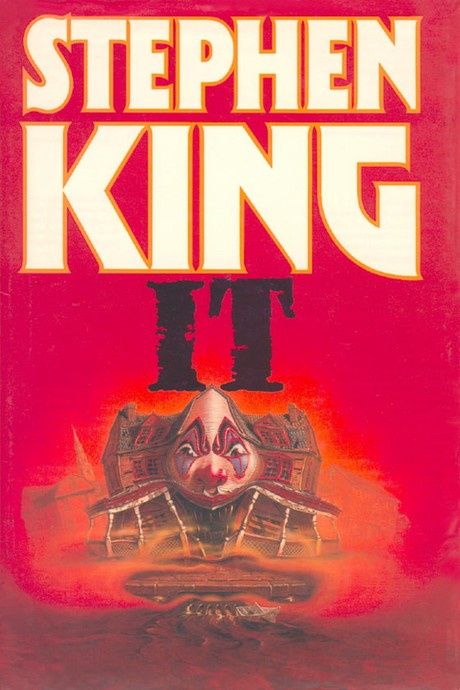
It's time to talk about “that scene.”
In the context of the story the children hurt It very badly and it scampers away, probably to die (they hope). They're left in the middle of a complicated sewer system, with no light and no easy way out of the maze. This part of their task done, the power that brought them to this confrontation is slowly leaving them and they feel alone and pretty sure they're going to die in these old pipes.
For this group facing down their greatest fears marks them taking their first steps into adulthood. It's their coming of age, taking responsibility when no one else can and leaving their childhood behind. That's the subtext, but then King takes it in the literal direction.
Beverly figures out that the reason they're lost is because their bond is dissolving. Their power to fight It came from this bond. She figures that the only way to reignite that power is... with sex. One by one she loves each of her friends and the benevolent force behind their mission returns just long enough so they can navigate their way out of the sewers.
King writes this scene as delicately as one could. It's not titillating, Bev has all the power the whole time and it's all told from her perspective. That said you're never going have a scene like this and not make it awkward. When I was a kid reading about same-age kids doing the dirty it still felt weird to me, like I was a Peeping Tom or something. As an adult reading this chapter amplify that weird feeling by about a thousand percent.
I get what he was going for, but like I mentioned above the whole coming of age bit was already there in the subtext. As a kid I thought it was fascinating that such a taboo subject was broached. As an adult I think it's overkill.
A big reveal at the end of the book, and once again something that hasn't been tackled in any adaptation so far, is that It is actually a She. Whatever creature It is It's pregnant and the adult Losers confront not only It, but the squirming egg sacks dropping off It as they finally put an end to Its terror. This was the reason the Losers Club was brought together by the force of good and light while It has been able to run rampant, eating generation after generation of children. The world's already bad enough with one It. How about a few hundred of them?
I do like how this opens up a potential for continuing It stories. King has never done that (even though he has revisited The Losers Club kids in 11/22/63 and teased “Pennywise Lives” in various books over the years), but I could see there being a continuation at some point where one of these hundreds of eggs survived the stomping feet of the adult Losers Club.
Pennywise, after all, is a mirror to the evils of society. It is described as being a glamour, a creature that can take the form of your greatest fears. In King's novel Pennywise is used to reflect the bullying, homophobia, child abuse, mob mentality and racism in our culture. All that is still there today, bubbling beneath the surface. In short, there's plenty of horrors for one of Its children to reflect back on us, should Sai King ever want to revisit Derry in a contemporary setting.
Whether he feels the itch to ever dip his toe back into these waters or not we'll always have that original book, a portal back to old friends and childhood monsters.
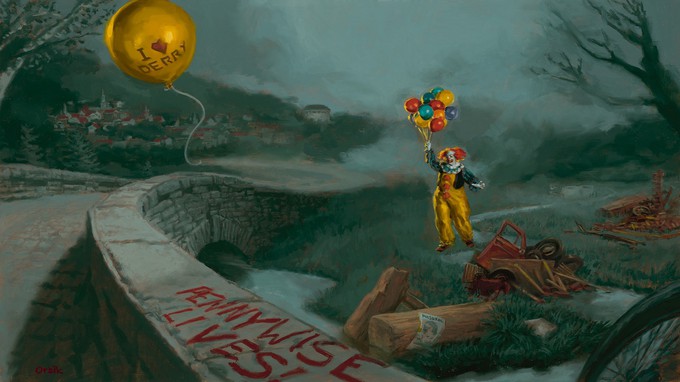
It as a novel is a high watermark for King and one that is surprisingly a fantastic gateway into reading for young teenagers, at least in my experience. In fact, I'd go so far as to suggest that it's ideal to read this story for the first time in your early teen years. Maybe not every kid could handle it at the age I was when I read it, but I think being close to the age of the kids at the center of the book allows the reader to relate to it in a way that you just can't as an adult.
There's a little extra something I got out of reading this book when I was 13 that I can feel now as an adult even if I couldn't put a name to it. It's fuzzy, more a feeling than a complete thought, but there's a bond with these characters and this story that I absolutely wouldn't have if I read it for the first time at 36.
I'm glad I read this when I did and this re-read has solidified its place as one of my all time favorite books. This thing hits me in a different way each time I've gone back to it and I expect if I wait another 10 years to read it again I'll have a slightly different read on it then, too.
I suppose that is the mark of great art, isn't it? Even though the words haven't changed the eyeballs reading it have. That's a form of magic to me and one of the reasons I love storytelling to much.
-Eric Vespe
”Quint”
quint@aintitcool.com
Follow Me On Twitter

